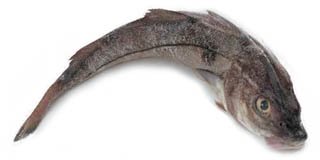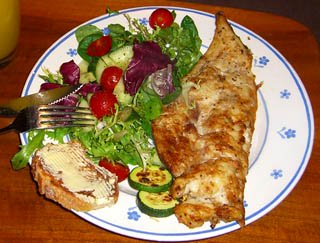Haddock fish Nutrition facts
Haddock is a popular fish often found in British and Scandinavian cuisine, prized for its non-oily, firm, and lean white flesh.
Haddock belongs to the Cod family of benthic fish that inhabit cold waters on both sides of the Northern Atlantic coasts.
Its scientific name is Melanogrammus aeglefinus.
Haddock fish is also known by various local names such as scrod in the US and eglefino in France.
 |
| Haddock fish (M. aeglefinus). Photo credit: Marinespecies.org |
Description
Haddock is a deep-oceanic, bottom-dwelling fish in the cod family, which also includes the pollock and the hakes. It possesses a round, streamlined body, with a dark purplish-gray hue on the top and sides, transitioning to silvery-gray below the black lateral line.
They can be distinguished from other cod family members by their smaller size and a black “thumbprint” (blotch) found on each side of their body.
Biology
Haddock is a fast-growing species, typically reaching lengths of 1 to 3 feet at maturity and weighing between 2 and 7 pounds. Its typical lifespan is around 10 years, with a common catch age ranging from 3 to 7 years.
Habitat
Haddock prefers a benthic (demersal) lifestyle, residing close to the ocean bed in deep waters at depths of 200-500 meters. Unlike some species, haddock does not undertake long-distance mass migrations.
Its diet consists of various bottom-dwelling creatures, including mollusks, worms, crustaceans, sea stars, fish eggs, and small fish such as herrings.
Health Benefits of Haddock Fish
Haddock, being a non-oily oceanic fish, is low in calories and saturated fats. With just 74 calories per 100 g, it boasts a lower calorie count compared to hake and cod.
It stands as one of the finest sources of essential fatty acids, protein, minerals, and fat-soluble vitamins such as vitamin A, E, and D.
The lean, firm, white meat of haddock provides a robust amino acid profile. With 16.32 g/100 g (29% of RDI), it offers complete protein composition, encompassing all essential amino acids in healthy proportions.
Haddock serves as a good source of polyunsaturated fatty acids (PUFA). Studies indicate that seafood consumption can decrease the risk of heart attack, stroke, obesity, and hypertension. Seafood, being low in saturated fat and rich in "heart-healthy" polyunsaturated fat, including omega-3 fatty acids, contributes to this effect.
With just 0.055 ppm of mercury in its flesh, haddock earns a place in the "best choice" section according to the US FDA's categorization based on mercury levels. The recommended consumption stands at 2-3 servings (8-12 ounces) per week for haddock fish.
Haddock provides a moderate source of omega-3 fatty acids, including eicosapentaenoic acid (EPA), docosapentaenoic acid (DPA), and docosahexaenoic acid (DHA). Research suggests that these fatty acids, particularly DHA, play a pivotal role in nervous system development, especially in infants and children.
According to a 2012 report from Cornell University and the New York Sea Grant Extension Program, fatty acids play a crucial role in decreasing blood pressure and heart rate, thereby improving cardiovascular function. Omega-3 fatty acids have been shown to reduce the risk of arrhythmias, which can lead to sudden death.
Large trials on adults, such as the "GISSI Prevention Trial, have demonstrated the efficacy of fish or fish oils in preventing heart disease. Participants who took a 1-gram capsule of omega-3 fats daily for three years were less likely to experience a repeat heart attack, stroke, or sudden death compared to those who took a placebo".
While haddock is a deepwater non-fatty fish with only a small amount of vitamin A in its flesh, its liver serves as an excellent source of omega-3 essential fatty acids like ALA, DHA, and DPA, contributing to healthy mucosa, hair, and skin.
Haddock fillet contains B-complex vitamins such as niacin and pyridoxine (B-6), along with vitamin E and vitamin B12, thiamin, and riboflavin.
Furthermore, it offers a natural abundance of minerals including iodine, calcium, zinc, potassium, phosphorus, and magnesium. Iodine, in particular, is a vital trace element essential for thyroid hormone synthesis.
| Principle | Nutrient Value | Percent of RDA |
|---|---|---|
| Energy | 74 Kcal | 4% |
| Carbohydrates | 0 g | 0% |
| Protein | 16.32 g | 29% |
| Total Fat | 0.45 g | 2% |
| Cholesterol | 54 mg | 18% |
| Dietary Fiber | 0 g | 0% |
| Vitamins | ||
| Folate total | 12 μg | 3% |
| Niacin | 3.363 mg | 21% |
| Pyridoxine | 0.281 mg | 21% |
| Riboflavin | 0.057 mg | 4.3% |
| Thiamin | 0.020 mg | 1.75% |
| Vitamin-A | 57 IU | 2% |
| Vitamin-B12 | 1.83 μg | 76% |
| Vitamin-C | 1.1 mg | 2% | Electrolytes |
| Sodium | 213 mg | 14.2% |
| Potassium | 286 mg | 6% |
| Minerals | ||
| Calcium | 11 mg | 1% |
| Iron | 0.17 mg | 2% |
| Magnesium | 21 mg | 4% |
| Phosphorus | 227 mg | 32% |
| Selenium | 25.9 mg | 47% |
| Zinc | 0.32 mg | 3% | Ω-3 Fatty acids |
| EPA (20:5 n-3) | 0.042 g | -- |
| DPA (22:5 n-3) | 0.005 g | -- |
| DHA (22:6 n-3) | 0.089 g | -- |
Purchasing Tips for Haddock Fish
Haddock fish are consistently available throughout the year, with peak quality experienced between December and February after they have fully recovered from spawning. During this time, they boast a plump and firm-fleshed texture.
In the United States markets, haddock is sold in various forms: whole, headed & gutted, or filleted. Additionally, specialty stores offer smoked (Finnan haddock) and salt-cured variations as value-added products.
When selecting haddock, opt for specimens with vibrant, firm flesh, silvery skin, pink gills, and clear eyes. Fillets may be presented with or without skin, though the distinctive 'thumbprint' skin is often retained to aid in distinguishing haddock from less desirable species.
Due to its perishable nature, haddock should be consumed promptly. When stored on ice, it typically remains in good condition for up to five days. However, it's advisable not to keep whole gutted fish on ice for more than two days, particularly if they are intended for smoking. For home storage, refrigerate fish and fillets for 1-2 days. For prolonged preservation, scale and gut whole fish before storing them in a deep freezer set below -30°C.
Preparation Tips
Fresh haddock is a versatile dish; treat it much like cod. If preparing the whole fish, keeping the skin intact helps hold the flesh together.
Haddock boasts a smooth flavor profile and readily absorbs the flavors of its surroundings. Its firm, white flesh, akin to cod, offers a less flaky texture and subtle taste.
Compared to cod, haddock flesh is firmer with a slightly sweeter taste and less flakiness, making it an excellent choice for smoking.
Marketers offer haddock either fresh or frozen, often selling single fillets from large haddock for dishes like golden cutlets. Smaller haddock are typically block-filleted.
Here are some serving ideas:
 |
| Grilled haddock with fresh herbs and vegetables. Photo credit: nhoglund |
Like other whitefish varieties, haddock can be served grilled, poached, or baked, paired with accompaniments such as curry or tomato sauce. Depending on the size, smaller fish are headed and gutted, suitable for stuffing, while larger fish are cut into steaks or filleted. The head portion often contains more flavorful flesh.
In Scotland, haddock reigns as the top choice for traditional "fish and chips."
It also lends itself beautifully to dishes like fish lasagna and pie, particularly when combined with an equal portion of smoked haddock.
Poaching smoked haddock in milk enhances its already rich flavor.
Haddock serves as a versatile substitute in recipes calling for hake, pollock, or cod.
Safety profile
Haddock fish typically contains a mean methyl-mercury concentration of 0.055 ppm. Following the U.S. FDA's guidelines regarding fish consumption for expectant and breastfeeding mothers, haddock falls under the "best choice" category.
By this yardstick, individuals in these groups can safely consume 2-3 servings (8-12 ounces) of haddock fish per week. (Medical disclaimer).
Also read ≻≻-
≺≺- Mercury in Fish: Health Benefits, Risks, and Safe Choices
≻≻- Salmon nutrition facts and health benefits.
≻≻- Hake nutrition facts and health benefits.
≻≻- Trout fish nutrition facts and health benefits.
≻≻- Dover sole nutrition facts and health benefits.
≻≻- Back to Seafood from Haddock fish nutrition facts and health benefits.
Further reading (Links opens in new window):
NOAA Fisheries-Species Fact Sheets -Melanogrammus aeglefinus.
Omega-3 Fatty Acids: An Essential Contribution.